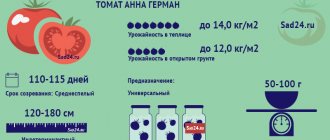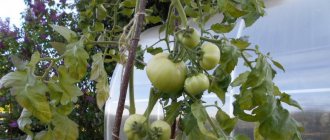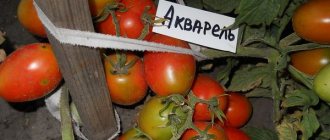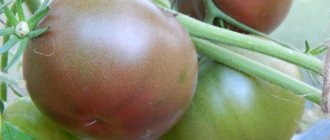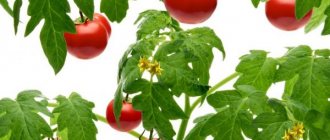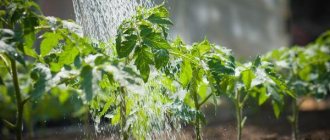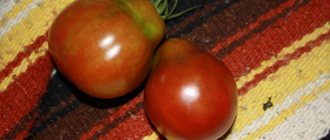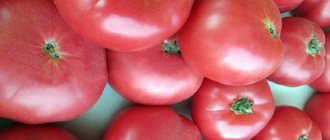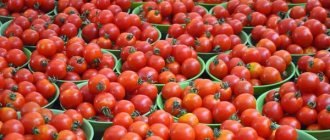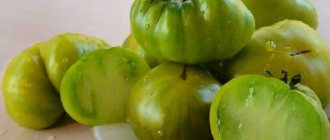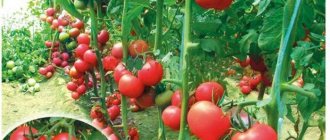Description of the variety
Fruit:
- Round shape;
- Those that have reached varietal maturity are bright red in color;
- With juicy, not watery, aromatic pulp, with a sugary taste;
- The number of seed chambers is from 3 to 4;
- Dry matter content up to 6%;
The average weight varies from 140 to 220 grams.
- Medium size.
Bushes:
- Indeterminate, standard plant with a powerful stem and good foliage;
- Grows up to two meters;
- The leaves are large in size, light green in color, matte, slightly corrugated;
- The inflorescence is simple. The formation of the first inflorescence occurs above the 8-9th leaf, further ones at intervals of three leaves.
Tomatoes in a greenhouse are an excellent harvest:
Characteristics and description of tomato
The hybrid was bred by Japanese breeders from the Sakata company. Recommended for breeding under film cover. Entered into the State Register of the Russian Federation in 2009.
Reference ! The Japanese company Sakata has been breeding for more than 100 years, since 1913. It has more than 10 of its own stations and research laboratories on 5 continents of the world.
Distinctive features
The type is indeterminate, grows more than 2 m, since the growth of the main stem is not limited. The root system is compact, which allows you to plant up to 5 plants per 1 m2. The foliage is dense, the stem is powerful. On each bush, 8–10 fruiting clusters are formed, which set 5–7 fruits.
The tomato is resistant to a number of diseases: verticillium, fusarium, tobacco mosaic virus and root nematode.
Reference ! Nematodes are representatives of a large group of roundworms that parasitize animals and plants. In a short period of time they can destroy all plantings.
Ripening time is average: the first fruits are harvested 100–110 days after sowing the seeds. Ovaries are formed in any weather conditions.
Productivity is high: up to 15 kg of fruits are collected from 1 m2.
Without additional support, the stem will not support the weight of heavy fruit-bearing branches, so staking of plants is necessary. Also, seedlings need pinching and shaping.
Fruit characteristics
Ripe vegetables are round, bright red, average weight ranges from 140 to 220 g. There are 3-4 seed chambers. The pulp is dense, which complicates the preparation of freshly squeezed and canned juices.
The taste is sweet, sugary, pronounced. The peel is dense, so the vegetables are stored for a long time and retain their presentation when transported over long distances. For these reasons, the crop is bred on an industrial scale.
The use of tomatoes is universal: they are not only ideal for preparing fresh dishes, but also do not lose their taste in winter preparations. The size of the fruits allows them to be preserved whole.
The photo shows Michelle f1 tomatoes.
Tomatoes: advantages and disadvantages
The main positive qualities of the tomato hybrid “Michelle” include:
- High yield;
- Varietal qualities of fruits;
- External presentation;
- Excellent taste characteristics;
- Immunity to characteristic diseases and pests;
- Long storage period;
- Possibility of transportation over long distances.
The increased demands on applied fertilizers and compliance with the irrigation regime are noted as minor drawbacks.
Description and characteristics of the tomato variety Chocolate Bunny, reviews, photos
A very productive, indeterminate variety of cherry tomatoes.
The bush is up to 1.2 meters high (often less), strong, spreading. If you don’t take steps, then there will be a “jungle”. The brushes are located very often. The variety is recommended for cultivation in greenhouses and open ground.
photo author Arkady Roman
Tomatoes are small creamy, smooth, dense, red-brown in color when ripe. The taste is sweet, tomato, slightly sour. In appearance, Chocolate Bunny tomatoes are very similar to the De Barao black variety, but they are definitely more productive.
The variety has extended fruiting. Ideal for whole-fruit canning, as well as for drying.
Resistant to major tomato diseases, not prone to cracking, and stores well.
Growing tomatoes
Hybrid "Michelle", like most tomato crops, is preferable to grow in seedlings.
How to prepare seeds?
Seed preparation technology:
- Since the Michelle tomato is a hybrid, planting material should only be purchased in specialized stores from well-known manufacturers. Also, the seeds do not require a disinfection procedure, since they undergo all necessary manipulations immediately before sale;
- To increase germination, seeds are treated with growth stimulants, soaking in the solution for 10-12 hours. Then rinse in clean water;
- It is better to sow seeds in sprouted form. To do this, they are placed on a damp cloth and left for 3-5 days. It is necessary to monitor the level of humidity and prevent the seed material from drying out.
Sowing seed material
Recommendations for sowing seeds for seedlings:
- For sowing, you can use either universal soil for tomatoes or self-prepared soil. The soil mixture should include garden or turf soil with the addition of humus. Such soil must be calcined in the oven to destroy all possible microorganisms;
- Containers for seedlings also need to be disinfected;
- Seed material is sown to a depth of 1.5-2 cm, with a distance of 2 cm from each other. Sprinkle a layer of peat on top;
- The planted seeds should be covered with a transparent film and placed in a room with a temperature range of +22 to +25 degrees;
- As soon as the first shoots sprout, the film is removed. The seedlings are exposed to bright light and the temperature is lowered to +18...+20 degrees to prevent the seedlings from stretching;
- After the formation of two true leaves, the seedlings are planted in separate pots and also fertilized with liquid organic fertilizer;
- Regularly water the plantings with warm water and provide 16-hour lighting, additionally using phytolamps;
- 7-10 days before the intended planting in a permanent place, they begin to harden the seedlings.
Rules for planting seedlings
How to plant seedlings correctly:
- Tomato bushes are planted as soon as warm weather sets in and the threat of return frosts has passed;
- It is advisable to use a bed where onions, garlic, cabbage, and legumes previously grew;
- Before planting, the soil is thoroughly loosened and fertilizers are added to it. However, you should not abuse nitrogen-containing fertilizers;
- Wood ash is added to each planting hole;
- It is recommended to plant no more than 5 tomato seedlings per 1 m2.
II. Indeterminate varieties (unlimited growth)
These are tomatoes that will grow until they turn blue until the owner or the onset of the cold season stops them. They have great yield potential, which is more successfully realized in high greenhouses. We place approximately three bushes on 1 square. With supports such as strong trellises, open ground is not prohibited, which will be especially welcome in the southern regions.
Tomato Scarlet candles
Good for pickling, sweet. This is a patented mid-early variety (Siberian breeders distinguished themselves!). In the state register since 2007. They are characterized by a high ability to form ovaries in any conditions. From 1 sq.m you can actually get a bucket and a half. The clusters are arranged in tiers, the weight of the fruit on the lower branches reaches 120 g, on the top ones - half as much.
Very lightweight. A mid-early Siberian variety for canning whole vegetables. The fruits are elongated, reaching (maximum in our conditions) 13-14 cm in length, weighing about 120 g, and have a beautiful crimson hue. They have few seeds, are very fleshy, strong, and easy to keep. If they are picked green, they do not spoil and ripen perfectly. The variety is very responsive to high-quality fertilizing.
The longest
A new product of Siberian selection. It begins to ripen already on the 110th (you can add a couple more) days from the sprouts appearing on the surface of the soil. Fruits have a unique length - 20 cm (specific size)! They are very elongated, with a small pear-shaped constriction in the upper part, uniformly slightly expanding downwards, with a spout.
High yield
The variety is productive and unpretentious. Tolerates slight shading. It ties well. Neither high nor low temperatures are scary. It succeeds in protected soil, but outdoor cultivation is not prohibited. Tomatoes begin to ripen in 106-113 days; at the same time, the plant successfully continues to grow and form clusters - up to 10 pieces per bush.
Each bears up to eight graceful fruits - cylindrical and pointed, in full ripeness - iridescent pink in color. The weight of each vegetable is 100-120 g. They contain a high percentage of sugars and dry matter. They do not burst when pickled, are good for drying, obtaining thick juice and, oddly enough in your opinion, for making tomato jam. With diligent care, the bush can bear up to a bucket of quality fruit.
Tomato Niagara
Weighty brushes
This mid-early vegetable variety has been on the state register since 2010. The bush is tall, but compact in width. It has a highly branched root system, responsive to increased nutrition and good water supply. A valuable feature of this Siberian variety is its multiple clusters, each of which bears up to 14 fruits weighing 85-115 g.
Meaty and sweet
This is one of the sweetest and meatiest products of Siberian breeders. It has been registered in the state register since 2007. The tomato is mid-season (116-118 days from the appearance of sprouts), with large foliage. The fruits resemble long, sharp peppers - they grow up to 15 cm. They are an elegant red color, the weight ranges from 120-185 g. The pulp of vegetables contains very little water and seeds. In the best case, there are up to a dozen fruits in one cluster. One bush gives 2-3 kg.
Tomato Koenigsberg
Excellent ovary
READ MORE: Potatoes belongings description of the variety with photos characteristics characteristics of cultivation reviews
Included in the state register in 2005. The variety rightfully takes its place among the most productive Siberian varieties (up to 20 kg per square meter of land in a greenhouse). It sets perfectly even in the hot atmosphere of closed ground. Plants with a powerful bush with large leaves require increased nutrition and careful pinching.
The first ovary is formed after the growth of the 12th leaf, then inflorescences are formed every 3 leaves. Refers to varieties of medium ripening; in Siberian conditions, approximately half of the crop ripens; the rest of the fruits turn red quite well when ripened. Tomatoes in the lower clusters of vegetables weigh 300 g, and in those above - no less than 150 g. The shape is elongated, heart-shaped, smooth, and beautiful.
Vitamin and sweet
Ripe tomatoes have a golden-orange color and contain a record amount of carotene vitamins. The pulp is sweet and aromatic, like berries and fruits. The ripening period is average. The lower fruits are capable of filling up to a mass of 400-450 g, higher up the bush - 200-300 g. They are oval, often with a spout. The plants grow clusters through the leaves, each containing on average, as stated, up to 5 fruits. Productivity is high. The keeping quality is excellent. It is especially tasty when salted with gelatin.
Harvest hearts
Close internodes and a powerful trunk with dense foliage are like standard varieties, only the height is two meters. The Siberian breeding novelty produces half a bucket of fruit from one such “tree”. Ripening begins on the 115th day. Forms up to 6 beautiful clusters with 5-7 red tomatoes weighing 200-250 grams, shaped like strawberries.
Tomato Budenovka
Resistant to cracking
https://www.youtube.com/watch?v=PHyOlHjgbBA
The variety is an improved version of Ox Heart, with a higher yield (about 9.4 kg per square), early ripening, good resistance to diseases (even to late blight) and cracking of the apical tissue of the fruit for a fleshy variety. Heart-shaped, ribbed tomatoes with excellent taste.
Record weight
The variety is a new product from a team of breeding scientists under the leadership of V.F. Gavrisha. Registered in the state register in 2015. Due to the unrealistically large fruits of vegetables, it is included in the “Russian Hero” series. The variety is not very fast in terms of ripening time (from 120 days), therefore it requires early planting of seedlings, especially careful pinching and decent feeding.
In Siberia and Central Russia it works well only in closed ground conditions, including a greenhouse. The average return from a bush is 3.6 (plus or minus) kg, the record is 7 kg. The tomatoes are flat-round, slightly ribbed, have an excellent smell and are very juicy, each weighing 400-600 g, not uncommon - 800 g. There are 2-3 tomatoes in one cluster of plants; if you leave only one tomato in it, it can pull more than 1 kg. Such “bogatyrs” are better suited for salads and distillation for juice.
Bowl of salad from one fruit
One of the best salad novelties, the yield is high. The plant bears 5-6 racemes. The fruits look very attractive due to their raspberry-pink color, large up to 500-800 g. The tomatoes are flat-round, ribbed, sweet. There is high resistance to cracking; The pulp density is average. A rare quality for large-fruited varieties: the fruits do not tend to quickly soften and spoil during storage.
According to the ripening period, the variety is classified as mid-early and mid-ripe. Perfect for preparing preparations: tomato paste, juice. This tomato variety is characterized by high yield. You can remove up to 5-6 kilograms of tomatoes from one bush.
Giant orange sweet
It has plasticity, rare for a large-fruited variety, and relative unpretentiousness. Delicate sweet pulp combines with excellent keeping quality. The tomatoes are round-flat (their “ribs” stand out a little), sunny orange in color. The average weight of a tomato is 0.5 kg, but in reality there are 1 kg of fruit on the bush.
Bush care
How to properly care for tomato plantings:
- Water moderately but regularly. Watering is carried out at the root, in the evening, using warm water;
- Weed, loosen and hill up the soil in a timely manner. This significantly improves soil aeration and also gets rid of weeds;
- To get a good harvest, it is recommended to form a bush into one stem;
- Tomato bushes need a garter to reduce the load on the branches;
- This hybrid requires and responds well to the application of fertilizers, which include potassium, nitrogen and phosphorus. The use of hormonal drugs is recommended, but in small dosages;
- As soon as the first inflorescence appears, the lower leaves need to be removed. This helps improve the supply of nutrients to the brushes and facilitates further care of the plantings.
Description of the hybrid tomato variety Michel, cultivation and planting rules
Hybrid tomato Michel F1 was bred by Japanese breeders. In 2009, it was registered in Russia and immediately gained popularity among farmers. Tomatoes grow well in any climatic conditions, under film cover, but they develop best in the southern regions.
What is a Michelle tomato?
Characteristics and description of the variety:
- Tomatoes ripen early; from the moment the seeds are planted, they ripen in 100-110 days.
- Productivity is stable, up to 4 kg of fruit grows on one bush.
- Up to 7 tomatoes are tied on one brush.
- Michel is an indeterminate standard variety that can reach 2 m in height.
- No branches or side shoots appear on it.
- The stem is powerful.
- This variety is resistant to nightshade diseases.
- The collected fruits are stored for a long time and tolerate transportation well.
Tomatoes are red in color and have a round and slightly elongated shape. The weight of one fruit reaches 220 g. The skin is of medium density. The inside of the fruit is fleshy and has four chambers. The amount of dry matter is 6%, which means that there is little watery mass. They have a sweetish taste and a pleasant aroma.
The Michel variety is suitable for canning, pickling, preparing tomato paste and adding to various culinary dishes.
Growing tomatoes
To grow healthy seedlings, you need to adhere to the classic rules of planting tomatoes.
The seeds are planted in a pre-prepared substrate, in grooves 1.5-2 cm deep. They are covered with a thin layer of earth and sprayed with water using a spray bottle. The container with the planted seeds is covered with a film to retain moisture in the soil and kept until sprouts appear at a temperature of +22…+25 ºС. Shoots should appear within a week.
After they appear, the film is removed, and the room temperature is lowered to +18...+20 ºС. At this stage, the plant needs light or light illumination for 16-18 hours. When the seedlings grow and the first leaves appear on them, they can be transplanted into separate pots.
Caring for seedlings consists of watering, feeding and hardening the plant. Watering is done once a week, as the soil dries out, replenishment is done once every 2 weeks, and hardening is done 2 weeks before the intended planting in the ground. It is useful to carefully loosen the soil; this procedure strengthens the root system of the plant.
In the first and next few days after planting, the plant will acclimatize and get used to new conditions. Therefore, the fewer procedures are done these days, the less stress the plant will endure.
Before planting, the soil must be loosened and saturated with fertilizers (try to use the least amount of nitrogen). Since this variety is standard, up to 5 bushes are planted per 1 m². Supports must be installed. Before the ovaries with fruits appear, you need to water the tomatoes sparingly. This procedure is performed either in the morning or in the evening.
After the first inflorescence appears, the leaves at the bottom of the bush must be removed. This will improve the supply of nutrients to the brushes and make caring for the plant easier. High yield and good taste of tomatoes are influenced by proper care.
The root system is greatly benefited by weeding, loosening and hilling the soil. The soil is thus improved and gets rid of weeds that take away nutrition from the plant.
Reviews from gardeners about tomato are positive. Farmers and summer residents note the high productivity of nightshades, the excellent taste and aroma of the fruits. Also, among the advantages of tomatoes, people highlight the versatility of using tomatoes. Housewives use them both fresh and for winter preparations.
moefermerstvo.ru
Diseases and pests
The tomato hybrid "Michelle" has excellent immunity to diseases and insect pests typical of tomatoes. However, do not forget about prevention:
- Do not allow the soil to become waterlogged;
- Carry out timely weeding;
- Apply complex fertilizers;
- In greenhouse conditions, tomatoes are attacked by greenhouse whitefly. To combat it, the effective drug “Confidor” is used;
- Cutworms also cause damage to plantings.
They are fought with insecticidal drugs that can destroy them.
How to grow tomatoes
Before planting seedlings in the soil, they dig it up and add a full range of minerals.
Landing
The compact root system makes it possible to plant up to 5 seedlings per 1 m2. A little sawdust or ash is placed in each hole 15 cm deep, which is filled with warm water.
The transplant is done on a cloudy day or in the evening. The seedlings are buried down to the first leaves, the soil is compacted and irrigated with warm water. While young bushes get used to new conditions, the soil is not moistened for a week.
Further care for tomato Michelle
The hybrid is demanding on watering and fertilizing. These are necessary conditions for its full development.
Water abundantly as the top soil layer dries out. However, there is no need to flood the seedlings: excess moisture may cause the roots to rot. To prevent the beds from drying out longer, they are mulched with peat or straw.
Loosening after watering ensures soil breathability. Oxygen supplied to the roots strengthens the plant's immunity.
Weeds take a lot of nutrients from the soil that are necessary for the growth of seedlings, so weeding is mandatory. In addition, fungal spores and many pests that are dangerous to crops of the nightshade family multiply in weeds, so proximity to weeds is extremely undesirable.
A full range of minerals is added from fertilizers. After transplantation, a fertilizer with a predominant nitrogen content is used; during flowering, phosphorus is added instead of nitrogen, and potassium substances are added at the time of fruiting.
Feed the crop once every 2 weeks. All fertilizing is combined with watering.
Features of care and possible difficulties
Without a garter, the stem will not withstand the weight of the fruit-bearing branches. Therefore, supports are installed next to each seedling, to which the stem and branches are fixed. A garter on a trellis is also possible. Between the supports installed on different sides of the bed, a wire is stretched horizontally, to which the plants are tied with synthetic material.
To get maximum benefit, it is recommended to form a bush with 1 stem. All other stepsons are removed once every 10 days. To avoid crowding of plantings, remove all lower leaves.
Peeling is carried out early in the morning so that by the evening all the wounds have time to heal. The cut areas are sprinkled with ash, ensuring disinfection.
Diseases and pests
The hybrid's genes contain good disease resistance, making it immune to many infections. However, we should not forget about prevention and increasing the immunity of seedlings.
With moderate watering, regular loosening, weeding and timely application of fertilizers, not only full development occurs, but also the strengthening of protective forces.
Before planting, the soil is spilled with a hot solution of manganese and treated with copper sulfate, thereby destroying fungal spores. This is especially important when growing tomatoes in a greenhouse.
If crops from the nightshade family grow next to tomatoes, it is necessary to regularly spray all plants with fungicidal agents. The drug “Fitosporin” has an effective preventive effect.
Dangerous pests include butterflies (more precisely, their caterpillars), whiteflies and cutworms. To combat whiteflies, use the drug “Confidor” or folk remedies (for example, planting basil, calendula and marigolds next to tomatoes). Herbs with their smell repel pests from the beds.
The smell of calendula repels not only whiteflies, but also cutworms. You can also spray the plants with a decoction of onion peels. Among the chemical preparations used are “Karate” or “Decis”.
Reference ! The cutworm is omnivorous. It destroys not only tomatoes, but also cabbage, beets, peppers and eggplants.
Productivity
Productivity with proper care and compliance with the recommended planting density (no more than 5 seedlings per 1 m2) reaches from 10 to 14 kg of tomatoes per 1 m2.
Which regions are best to grow in?
Both southern, central and even northern regions are suitable for growing the hybrid tomato “Michelle”, when cultivated in heated greenhouse structures.
REFERENCE: It is allowed to grow in the southern regions in unprotected soil, without compromising productivity, despite the recommended cultivation in greenhouse conditions.
The nuances of growing in open ground and greenhouses
The crop is recommended for cultivation under film cover, but residents of the southern regions successfully grow it in open ground. In more severe weather conditions, tomatoes grow in heated greenhouses. Regardless of external factors, taste properties and quantitative indicators are maintained at the proper level.
To limit the growth of the main stem, pinch the crown of the plants. After this, all the energy of the bush is spent on the formation of fruits, and not on further growth.
Closed structures must be ventilated daily. This maintains humidity and temperature within normal limits, which prevents the development of fungal diseases. In addition, fresh air destroys the usual habitat of the main greenhouse pest - spider mites.
Reviews about the variety from those who planted
Gardeners respond positively to the tomato hybrid “Michelle”. Due to its high yield, excellent taste and aromatic fruits, the tomato is in demand among farmers and homeowners. Also, the advantages of the hybrid include the universal purpose of tomato fruits, which allows them to be consumed both fresh and for preparing winter preparations.
The tomato hybrid "Michelle" is popular among gardeners due to its high resistance to most diseases and pests. It also guarantees a consistently high yield and a long storage period for the tomato crop.
Gardeners' opinion
Good afternoon! After positive reviews about the tomato, Michelle f1 decided to test it for herself. The fruits ripened after 4 months, the plant turned out to be unpretentious in care. Loves abundant watering and fertilizing, it definitely needs to be tied up. The yield is good; we managed to get 12 kilograms of tomatoes per square meter of planting. I recommend!
Evgenia Sizova, 54 years old.
I advise all lovers of large-fruited tomatoes to try the Michel variety. The hybrid shows high productivity. The fruits are juicy, sweet and very aromatic. Suitable for salads, excellent for fresh consumption.
Valeria Petrova, 63 years old.
